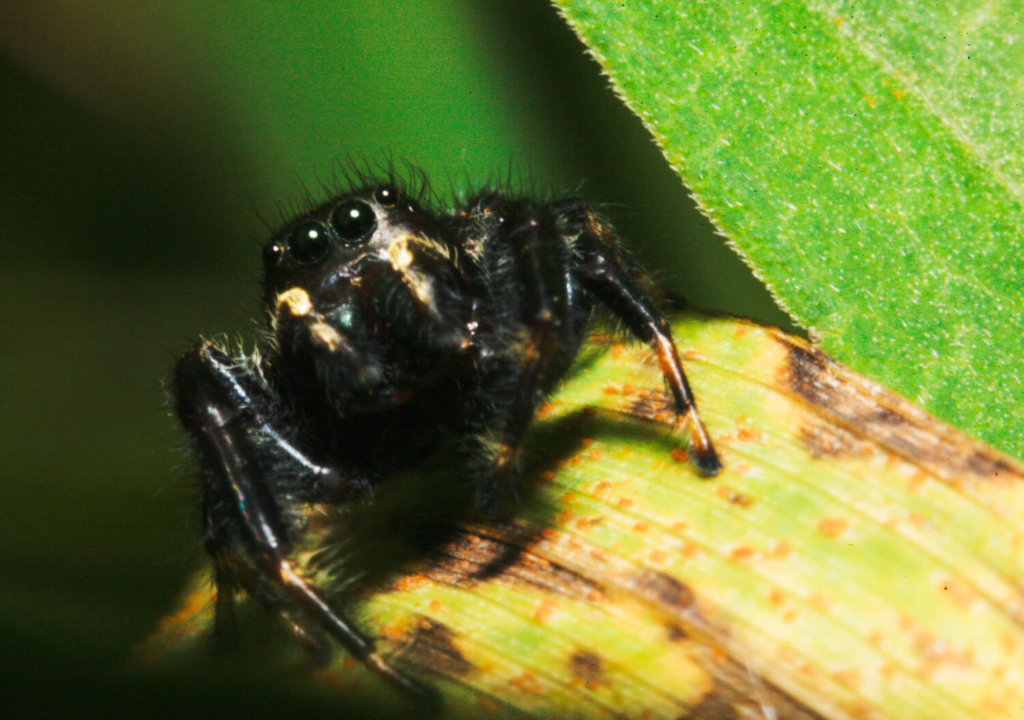Jumping spiders, there’s more than meets the eye

I’m not a huge fan of spiders. My mother-in-law, Lillian, never kills them when she finds one inside because she thinks spiders are amazing! She either just lets them be or gently moves them outside. I try to emulate her now and then, but most times, I just don’t want them inside!
A few months ago my son started taking close-up pictures of leaves and flowers and insects, and the most interesting pictures were of spiders! Observant readers will know I’ve already made a mistake. Spiders are not insects. They are arachnids, which have eight legs instead of six. Ticks and scorpions are also arachnids, and in total there are about 45,000 species of spiders!
The spiders most willing to model for him were jumping spiders. It turns out these are fascinating little creatures. At no larger than half an inch long they are the little spiders you sometimes find inside jigging and jagging around. They don’t live in webs but can produce silk if need be as a dragline to catch themselves if a jump is off target.
Here in Vermont, a few species of jumping spiders are common. One you might find on an outside wall or other vertical surface is a tan jumping spider—which isn’t exactly tan but a mottled mix of black, gray and white. The zebra jumper is mostly dark gray with white, zebra-like stripes on its abdomen. The most common jumping spider in Vermont and also North America is known as the bold jumper. There are two distinguishing characteristics of this species: they are mostly black with a white, orange or red triangular patch on its abdomen, and their jaws are iridescent in colors like blue or green. Of course, you’d only notice this if you got up close and personal with your local jumper!
The most amazing thing about jumpers, and one you’d never know if you didn’t look at magnified pictures, is that jumping spiders have four pairs of eyes! Actually most spiders have eight eyes, but as a hunting spider, rather than a web-weaving spider, jumpers have excellent vision so they can pounce precisely on their prey. They don’t have eyeballs like us, but they can focus on different objects (or prey!) by moving the retina at the back of these long tubular organs. When you see a jumping spider it will, supposedly, track you, either by moving its body or moving its retina, so you’re in its field of vision. They are watching you!
If they are such good hunters, what are they hunting? They like to eat other spiders and insects, such as crickets, moths, flies and grasshoppers. Many web-building spiders wrap their dinner in a web so it can’t get away, but jumpers inject their prey with a venom that paralyzes them. Then they can take their time and eat their meal in peace. Should we be worried about getting immobilized by these spiders? No, there’s not concern about that since they are so small, and we, even as children, are much larger!
I wondered if spiders have friends. It turns out that once they are large enough to leave the place they were born, they are on their own. The one exception to this is when a male spider dances for a female spider. It seems like she takes her time as she decides whether to mate with a fellow or not, and much of this decision is based on how well he dances! Feel free to put down The Charlotte News for a moment and look for videos of jumping spider-mating dances. The male will stick his front legs up in the air and wave them around and point them at the female as if he’s putting her under a spell, which he is in a way. If his dance is sufficiently mesmerizing, then rather than running away when he approaches the female will allow him to mate with her.
So take a second look the next time you see a little spider and see if it’s a jumper. Some of the information on these spiders come from pest-control websites. One says they are “intelligent, colorful, and have distinct personalities.” I’m not sure about how much of their personality you’ll be able to discern, but either way, now you know a little more about them!
Susan Blood is a Charlotte resident and a member of the Charlotte Conservation Commission. This group meets monthly on the fourth Tuesday at the Town Hall at 7:00 p.m. Meetings are open to the public.

